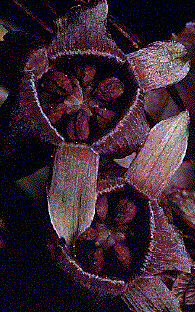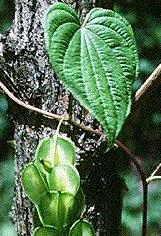
Dioscoreales
Air potatoes and Bat flowers
The Dioscoreales are primarily a tropical group, with a few species in
Europe and temperate America. Most are vines or climbing plants, but some
are herbs as well. The Dioscoreales include 600 species of Dioscorea,
and about 35 species in other genera. The group is not especially large, but
the genus Dioscorea is common in wet tropical regions
around the world. In many countries, it is cultivated for its starchy tubers,
sometimes called air potatoes or Chinese yams. Another member of the order,
the large herb Tacca, is a common horticultural oddity favored by
florists -- it is one of the few plants with blackish flowers, as shown at right.
A common characteristic of most Dioscoraleans is a thick, starchy
underground stem called a tuber. The tuber provides an energy store
for these plants, whose leaves and above-ground portions die back each year.
The stored food allows the plants to begin growth again when conditions are
favorable. The tubers of Dioscorea are full of starch and nutrients,
and so are boiled and eaten in many cultures. These provide the primary
source of carbohydrate for about 70 million people in more than a dozen
countries in tropical Africa, as well as for peoples in southern Asia and parts
of the Americas. The plants are propogated by cutting up the tubers, rather
than from seed, as there are not usually many seeds produced.
 The Dioscoreales are among those basal
monocot
groups which do not fit the textbook description of a monocot. In particular,
the leaves have a reticulated venation reminiscent of the
paleoherb dicots,
and may be heart-shaped or highly lobed.
For this reason, the Dioscoreales have at times been considered the most
"primitive" of monocots, but although they may retain many characters found
in early monocots, they now appear to be more closely related to the
Liliales.
The picture at left shows the leaves and fruits of Dioscorea;
click on the image to view more of it.
The Dioscoreales are among those basal
monocot
groups which do not fit the textbook description of a monocot. In particular,
the leaves have a reticulated venation reminiscent of the
paleoherb dicots,
and may be heart-shaped or highly lobed.
For this reason, the Dioscoreales have at times been considered the most
"primitive" of monocots, but although they may retain many characters found
in early monocots, they now appear to be more closely related to the
Liliales.
The picture at left shows the leaves and fruits of Dioscorea;
click on the image to view more of it.
The fossil record of the Dioscoreales appears to extend back into the Upper
Cretaceous (Maastrichtian).
Broad heart-shaped leaves with reticulated
venation are known from the Ripley Formation of the southeastern
United States, and these are quite similar to
some species of Dioscorea. The identity of these leaves is not
entirely certain, however, since the leaves of Smilax in the
Liliales are very similar. Only with further work, or with the discovery
of preserved flowers, will the identity of these fossils be determined.
The Dioscoreales may be divided into the following families:
Trichopodaceae - Trichopus zeylanicus
Dioscoreaceae - air potatoes (625 species), mostly Dioscorea
Taccaceae - only Tacca, the "bat flower", with ten species.
For more information about the Dioscoreales, try the
Dioscoreaceae and Taccaceae Resources Lists at Texas A&M,
or the DELTA descriptions for the
Taccaceae,
Trichopodaceae, and the
Dioscoreaceae
Texas A&M Botany has a collection of images of the
Dioscoreaceae and
Taccaceae.
You can also view images of Dioscoreaceae at University of Wisconsin.
View images of Malagasy Taccaceae at the Missouri Botanical Garden

Image of Tacca courtesy the Jepson Herbarium; image of Dioscorea courtesy Virtual Foliage. Used with permission.
Sources:
C. P. Dahglian. 1981. A review of the fossil record of monocotyledons.
Botanical Review 47(4):517-555.
R. M. T. Dahlgren, H. T. Clifford, and P. F. Yeo. 1985. The Families of the Monocotyledons, 520 pp. Springer-Verlag, Berlin.
C. A. Segnou, et al. 1992. Studies on the reproductive biology of white yam
(Dioscorea rotundata Poir.). Euphytica 64:197-203.


 The Dioscoreales are among those basal
monocot
groups which do not fit the textbook description of a monocot. In particular,
the leaves have a reticulated venation reminiscent of the
paleoherb dicots,
and may be heart-shaped or highly lobed.
For this reason, the Dioscoreales have at times been considered the most
"primitive" of monocots, but although they may retain many characters found
in early monocots, they now appear to be more closely related to the
Liliales.
The picture at left shows the leaves and fruits of Dioscorea;
click on the image to view more of it.
The Dioscoreales are among those basal
monocot
groups which do not fit the textbook description of a monocot. In particular,
the leaves have a reticulated venation reminiscent of the
paleoherb dicots,
and may be heart-shaped or highly lobed.
For this reason, the Dioscoreales have at times been considered the most
"primitive" of monocots, but although they may retain many characters found
in early monocots, they now appear to be more closely related to the
Liliales.
The picture at left shows the leaves and fruits of Dioscorea;
click on the image to view more of it.



